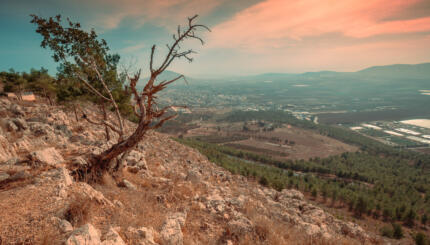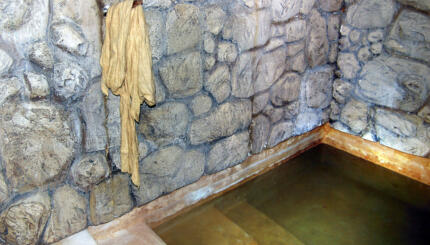Many of us had not seen each other for decades. Most of them I barely recognized. It was the 40th reunion of the Young Judaea Year Course in Israel and we were sitting around in a large circle on Friday night after dinner at Kibbutz Ketura and singing the songs that we used to sing together.
As we sang “Yerushalayim Shel Zahav,” Jerusalem of Gold, memories and emotions flooded my consciousness; it was hard to hide the tears moistening my eyes. So much of my identity is bound up in that song and with the friends in whose company I have sung it untold times.
But I am no longer the same person who naively sang the song in days gone by. This time I was torn, even hurt, by its haunting lyrics.
How dried up are the water cisterns; the market square so empty.
And none visit The Temple Mount in the Old City.
And in the caves in the stone, spirits wail.
And none go down to the Dead Sea by the Jericho Road.
Naomi Shemer wrote these words just weeks before the Six-Day War in 1967. The city was divided, with the Jordanians in control of the Old City. A forbidding wall and rows of barbed wire prevented Jews from approaching the Kotel (Western Wall), the Temple Mount, and the cobblestone alleyways of the Jewish Quarter.
It dawned on me that the cisterns were not dry. The markets were not empty. The road connecting Jerusalem to Jericho was not abandoned.
But for Naomi Shemer they were. The imagery of the lyrics erase the Arab citizenry as if they simply did not exist. And to sing the song is to buy into that narrative that we are the only people that matter in this land. This is the song of my soul, but its resonance has been replaced by dissonance.
Immediately after the war, when we captured the Old City and reunited the two parts of Jerusalem, our beloved Naomi Shemer responded to the miracle and composed a final stanza:
We have returned to the water cisterns, to the market and to the square.
A shofar calls from the Temple Mount in the Old City.
And in the caves in the stone, thousands of suns are shining.
We shall return and go down to the Dead Sea by the Jericho Road.
I was among those who returned – after 2,000 years of exile – to the cisterns and to the markets. My soul heard the sounding of the shofar at the close of the Six-Day War as signaling the end of our estrangement from the holiest place on earth.
But today I see what Naomi Shemer could not see. If all was forlorn and empty before we returned, if thousands of shining suns have replaced the howling winds of ghosts, then today we are alone in our holy city and only we traverse the road from Jerusalem to Jericho.
But that is not the case. I can no longer live as if the Arabs who live here are not here or don’t belong here. I can no longer be part of an empowered majority that renders an inconvenient minority invisible.
——————-
As a peace activist residing in Gush Etzion (in the West Bank) which has recently been the scene of repeated terrorist attacks, I was interviewed last week on Israeli prime time television about my thoughts in these troubled times. At the end of the interview I talked about a relatively new Hebrew children’s book entitled “Ha’Alon haBoded Misaper,” the Lone Oak Tells His Story.
The 600-year-old majestic Lone Oak is at the center of the Gush Etzion settlements, the symbol of the renewed Jewish settlement in the Judean Hills. This delightful and sensitive book tells how the tree was so happy when the first Jewish settlers arrived in the 1940s and how it was so delighted when their children arrived and played under its branches.
But then, says the tree, everything began to change and shots were fired all the time. The people were worried and the children were evacuated. The enemies from the surrounded villages killed or captured all the people and destroyed all that had been built. “And I”, says the tree “remained alone. I was very sad and alone, all alone. The children were so far away and I missed them dearly.”
From 1948 to 1967, the Lone Oak suffered from terrible loneliness because there were no children to play with. But that all changed when the children, now grown up, returned to Gush Etzion. They embraced the tree in great affection and exclaimed, “Here is the tree, here is our Oak tree. The tree embraced them … and shed tears of joy.”
I told the television interviewer that I love the Hills of Judea. This is the land of the Bible, where Abraham walked and where King David ruled. This is were the Maccabees fought and were victorious. Thirty-five years ago when I moved here the Lone Oak took root in my heart and has flourished within me every since. My children were born and raised under its boughs.
But the book reflects and engenders a perception of reality that I no longer share. The tree was not alone from 1948 to 1967. There were people here, and those people even had children. And I imagine that the fact that those people were not Jewish did not greatly bother the Oak.
We act as we sing in our songs and as we write in our children’s literature. If in our songs and in our bedtime stories the other is invisible, so will they be in our actions.
It seems clear to me that we delude ourselves at our own peril. The only way I can live is in the complexity of the fullness of reality. There will only be peace and reconciliation when both sides recognize the presence of the other and his rootedness in this little sliver of land that we both call home.
The tree, I said at the close of the interview, belongs to all of us.
Jewish food, holidays, Torah, Shabbat, history, blogs and more in your inbox – sign up now!
Kotel
Pronounced: KOH-tell, Origin: Hebrew, Western Wall in Jerusalem, Judaism's holiest site.
shofar
Pronounced: sho-FAR or SHO-far, Origin: Hebrew, a ram’s horn that is sounded during the month of Elul, on Rosh Hashanah, and on Yom Kippur. It is mentioned numerous times in the Bible, in reference to its ceremonial use in the Temple and to its function as a signal-horn of war.



